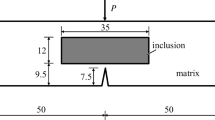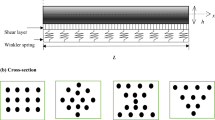Abstract
In this paper a hybrid finite element method is applied in evaluation of the stress intensity factors K I and K II of unidirectional fiber reinforced composites. In order to satisfy the stress singularity at the crack tip a singular super-element based on a modified complementary energy principle is developed. The stress and displacement fields in the super-element are expressed in terms of polynomials of two complex variables ξ1 and ξ2 in the transformed ξ-plane. The stiffness matrix of the super-element was determined by using a line integral along the boundary of the super-element. The displacement vector was expressed in terms of the element nodal displacement vector {q} and a properly selected shape function defined along the element boundary.
Numerical results for K I and K II of glass-epoxy and graphite-epoxy unidirectional composites with cracks along the diameter of a circular cut out as well as elliptical cut outs were evaluated
Résumé
On applique, dans la présente étude, une méthode d'éléments finis hybrides à l'évaluation des facteurs d'intensité de contrainte KI et KII pour des composites renforcés de fibres unidirectionnelles. Pour tenir compte de la singularité de la contrainte à l'extrémité de la fissure, on développe un super élément singulier en se basant sur un principe modifié d'énergie complémentaire. Les champs de contraintes et de déplacements dans le super-élément sont exprimés sous forme polynormale de deux variables complexes ξ1, et ξ2 dans le plan de la transformée. La matrice de rigidité du super élément est, quant à elle, définie en utilisant une intégrale linéaire le long du contour de l'élément. Le vecteur de déplacement est exprimé par un vecteur (9) de déplacement nodal de l'élément, et par une fonction de forme appropriée, définie le long du contour de l'élément.
On évalue les résultats numériques pour KI et KII, correspondant à des composites à fibres unidirection-nelles de types verre-epoxy et graphite-epoxy, oú des fissures se situeraient sur le diamètre de découpes circulaires et elliptiques
Similar content being viewed by others
References
P. Tong, T.H.H. Pian, and S.J. Lasry, International Journal for Numerical Methods in Engineering 7 (1973) 297–308.
P. Tong, International Journal for Numerical Methods in Engineering II (1977) 377–382.
S.G. Lekhnitskii, Theory of Elasticity of an Anisotropic Elastic Body, translated by P. Fern, Holden-Day Inc., San Francisco, CA (1963).
G.S. Sih, P.C. Paris and G.R. Irwin, International Journal of Fracture Mechanics 1 (1965) 189–203.
K.R. Gandhi, “Analysis of an Inclined Crack Centrally Placed in an Orthotropic Rectangular Plate”, AMMRC TR 71–31 Army Material and Mechanics Research Center, Watertown, MA (1971) 1–19.
B.D. Agarwal and L.J. Broutman, Analhsis and Performance of Fiber Composites, Wiley-Intersciences, John Wiley and Sons, New York (1980).
Author information
Authors and Affiliations
Rights and permissions
About this article
Cite this article
Khalil, S.A., Sun, C.T. & Hwang, W.C. Application of a hybrid finite element method to determine stress intensity factors in unidirectional composites. Int J Fract 31, 37–51 (1986). https://doi.org/10.1007/BF00033928
Received:
Revised:
Issue Date:
DOI: https://doi.org/10.1007/BF00033928




